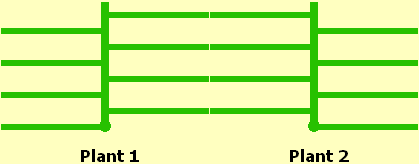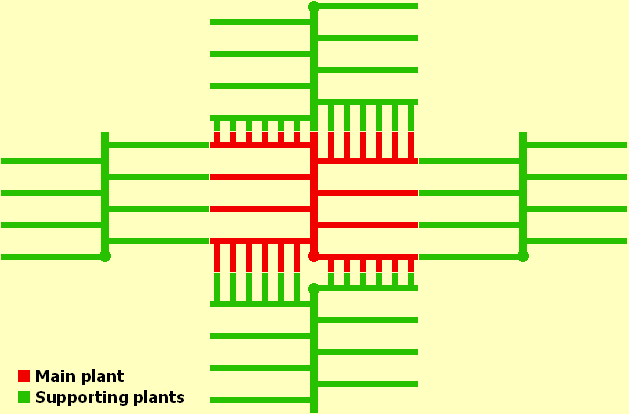Connecting two or more pumpkin/squash etc. plants through grafting
| My Seedlist | GIANT PUMPKINS | Seed
exchanges / Seed swaps Links |
||
| Direct Root Feeding | Sun Looking Leaves | Connecting plants by grafting | ||
My English is not perfect, I hope you will understand what I mean. Also I will appreciate any corrections.
The
thought of connecting two or more plants through
grafting came in my mind in 2005. As usually happens the first
attempts were not successful, including the
most obvious way:
 (This method doesn't work
because every piece of vine after the last
leaf/root dries out. Obviously plant stops the juice
flow after
the last leaf/secondary root). In late 2006 season finally found a
working method. After two seasons - 2007 and 2009 of experimenting with
it (2008 and 2010 were zero years for me), decided that it's
ready
to be shared
with all other growers, as I always did before with my other
experiments.
(This method doesn't work
because every piece of vine after the last
leaf/root dries out. Obviously plant stops the juice
flow after
the last leaf/secondary root). In late 2006 season finally found a
working method. After two seasons - 2007 and 2009 of experimenting with
it (2008 and 2010 were zero years for me), decided that it's
ready
to be shared
with all other growers, as I always did before with my other
experiments.
What I know
As you see there is a juice flow through the graft. But one connection between two plants is not enough. Often the graft looks very good, but when you split it you see that only a fraction of the whole length has taken (such case is shown in the video). This is very common when grafting plants with different vine thickness. At time of the grafting the vines are still young (top parts of the vines (but not at the very top)) and with relatively same thickness, but after that they continue to grow non-symmetrically and the result is logical. But even if it "catch" perfectly I doubt it will be as pervious/permeable as a healthy vine. So, more grafts should be much better!What I do not know
Despite the unquestionable juice flow I still can't arguably say how beneficial is this for the fruit growth. In 2007 I connected all my plants (3 main and only 1 supporting), so I have no base for comparison. In 2009 I again used bad scheme - 2 pairs of opposing plants. One of the grafts partly "took" (shown in the video) the other didn't (the graft that I make in the video is late. I made it only to show how, so it plays no role - it connects the supporting plant with the plant which produced the 165 kg. fruit). So I ended with 3 pumpkins. The heaviest one - 176 kg. (shown in the video) was from the connected plant. The other two were 165 and 145 kg. But this proves nothing. So after realizing that one graft is not enough next step should be to determine how much the supporting plant(s) affect fruit growth. In theory those two or more connected plants should act as, or nearly as one plant. Luckily this can easily be determined experimentally in the following manner:Connect two or more plants with at least 5-10 grafts (better more) between each pair of plants. Pollinate their first female flowers. That way the main plant will stay smaller and will become more dependent on the supporting plant(s), this should enhance the desired effect. Let's hope at least one of them will take. Leave one fruit on one of the plants (called here "main plant"). During it's peak growth cut the connections between the plants. If next few days there is significant gain drop - it works, otherwise - it doesn't work as well! As you see it's very simple, but and quite "pricy" in terms of space and time. And since I'm growing hundreds other species and varieties, again, I'm not sure I could spare enough space and time to do it myself. So if any of you has enough space, time and desire to do it...
Few grafting schemes


Simple and promising. Gives double chance - to choose the best fruit between two plants without wasting the other plant - the fruit will be wasted, but the plant itself will continue to serve. But probably this scheme, with only one supporting plant, will not allow first female flower pollination without reducing the final fruit weight.

Possible triple chance! There is one big question - what if we keep fruit on, let's say, the left plant instead on the middle? Can the right one feed the left one? This question can be answered through the described experiment with a small modification - during fruit's peak growth first cut the connections between the middle and the right plant. If next few days there is no gain drop then it doesn't feed it.

The ultimate scheme!
Theoretical benefits:
- Biggest benefit - It's obvious - much earlier pollination, up to first female set. That way the growing fruit will use more of the long and warm June days (compared to September-October). Also the fruit will be fed longer by younger leaves which photosynthesize better than the older leaves. (Because of these points I'm supposing that if the grower didn't pollinate early the fruit not only will miss these benefits, but on top of that the supporting plants may become (nearly) redundant, because with every additional day the fruit's mother plant will become larger and larger, thus capable to supply, bigger and bigger portion of it's needs.)
- Now the grower can plant more good seeds on same space and to select the most promising among them at much later time. This will reduce the cases with unused patches because of bad genes.
P. S. I strongly recommend you to try and the so called Sun Looking Leaves pruning method, described here. I truly believe it will prove beneficial.